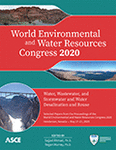World Environmental and Water Resources Congress 2020
Some Performance Characteristics of Subsurface Gravel Wetlands for Stormwater Management
Publication: World Environmental and Water Resources Congress 2020: Water, Wastewater, and Stormwater and Water Desalination and Reuse
ABSTRACT
Subsurface gravel wetlands were originally purposed for wastewater treatment and more recently have been used for stormwater treatment as a green infrastructure technology. Systems are sized to hold the water quality volume above, and drain within 24–48 hours. Design guidance follows static sizing principles with very little hydraulic calculations, which has left a gap in hydraulic performance data. Data from 12 years of field monitoring of various systems constructed in the northeast United States is presented. These systems include fully-sized as well as undersized (hold less that the water quality volume). Hydraulics are controlled by a restrictive outlet. At the same time, this outlet also creates the wetland characteristics of the system. Pollutant removal efficiencies for common stormwater pollutants are some of the highest for green infrastructure systems, with a significant component being microbially-mediated in the low dissolved oxygen gravel layers.
Get full access to this article
View all available purchase options and get full access to this chapter.
REFERENCES
Claytor, R. A., and Schueler, T. R. (1996) Design of Stormwater Filtering Systems. The Center for Watershed Protection: Silver Spring, MD.
Egan, T.J. S. Burroughs and T. Attaway (1995) "Packed Bed Filter." Proceedings of the 4th Bienial Symposium on Stormwater Quality. Southwest Florida Water Management District. Brookeville, FL. pp.264-274.
Georgia Stormwater Management Manual, Volume 2: Technical Handbook, First Edition, August 2001, prepared by AMEC Earth and Environmental Center for Watershed Protection, Debo and Associates, Jordan Jones and Goulding, Atlanta Regional Commission.
Gunderson, Jeff, Robert M. Roseen, Thomas P. Ballestero, Alison W. Watts, James H. Houle, and Kim Farah, 2012, Subsurface Gravel Wetlands for Stormwater Management, Stormwater, Forester Communications, Nov-Dec 2012.
Kadlec, R. H., and Wallace, S. D.; Treatment Wetlands. Second edition. CRC Press, Taylor & Francis Group. Boca Raton, FL, 2009.
Reed, Sherwood C., 1995, Natural Systems for Waste Management and Treatment / Edition 2, McGraw-Hill
Reuter, John E., Tjut Djohan, Charles R. Goldman, 1992, The use of wetlands for nutrient removal from surface runoff in a cold climate region of California—results from a newly constructed wetland at Lake Tahoe, Journal of Environmental Management, v36, Pages 35-53
Tetra Tech, 2016, Opti-Tool for Stormwater and Nutrient Management, US EPA Region 1, Boston, MA. Available at: https://www3.epa.gov/region1/npdes/stormwater/ma/opti-tool-user-guide.pdf
US EPA, 1983, Results of the Nationwide Urban Runoff Program, Volumes 1 and 2, Water Planning Division, WH-554, Washington, DC
USEPA, 1993, Subsurface Flow Constructed Wetlands for Wastewater Treatment, A Technology Assessment, Office of Water, EPA 832-R-93-008, Washington, DC.
UNHSC, 2007, University of New Hampshire Stormwater Center 2007 Annual Report, Durham, NH.
UNHSC and NEIWPCC, 2010, Investigation of Nutrient Removal Mechanisms of a Constructed Gravel Wetland Used for Stormwater Control in a Northern Climate, Durham, NH
UNHSC, 2016a, Subsurface Gravel Wetland Design Specifications, Durham, NH. Available at: https://www.unh.edu/unhsc/sites/default/files/media/unhsc_gravel_wetland_spec_6-2016.pdf
UNHSC, 2016b, University of New Hampshire Stormwater Center 2016 Annual Report, Durham, NH.
Winer, Rebecca. 2000. National Pollutant Removal Performance Database. Center for Watershed Protection.
Information & Authors
Information
Published In
World Environmental and Water Resources Congress 2020: Water, Wastewater, and Stormwater and Water Desalination and Reuse
Pages: 125 - 135
Editors: Sajjad Ahmad, Ph.D., and Regan Murray, Ph.D.
ISBN (Online): 978-0-7844-8298-8
Copyright
© 2020 American Society of Civil Engineers.
History
Published online: May 14, 2020
Published in print: May 14, 2020
Authors
Metrics & Citations
Metrics
Citations
Download citation
If you have the appropriate software installed, you can download article citation data to the citation manager of your choice. Simply select your manager software from the list below and click Download.
